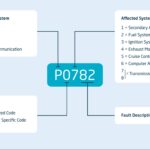Transform your cell phone into a powerful diagnostic tool with a cell phone car scanner. Utilizing an OBD2 adapter and a compatible app, you can unlock real-time data, diagnose issues, and monitor your car’s performance like never before. This guide explores how these tools work and the benefits they offer.
Understanding Cell Phone Car Scanner Tools
A Cell Phone Car Scanner Tool consists of two main components: an OBD2 adapter and a mobile app. The OBD2 adapter plugs into your car’s OBD2 port, typically located under the dashboard, and communicates with the app via Bluetooth or Wi-Fi. The app then interprets the data from your car’s engine control unit (ECU) and displays it in a user-friendly format.
Features and Benefits of Car Scanner Apps
Car scanner apps offer a wide range of features, including:
- Real-Time Data Monitoring: View live data from various sensors, such as engine speed, coolant temperature, fuel pressure, and more. Create custom dashboards to display the information most relevant to you.
- Diagnostic Trouble Codes (DTCs): Read and clear DTCs, which indicate specific problems within your vehicle’s systems. Most apps include a database of DTC descriptions to help you understand the issue.
- Freeze Frame Data: Access freeze frame data, which captures sensor readings at the moment a DTC is stored. This information can provide valuable clues for diagnosing intermittent problems.
- Emissions Readiness Check: Determine if your vehicle is ready for emissions testing.
- Performance Monitoring: Track acceleration times, fuel consumption, and other performance metrics.
- Customizable Displays: Tailor the app’s interface to display the information you need, in the format you prefer. Some apps even offer a heads-up display (HUD) mode to project data onto your windshield.
- Vehicle Specific Features: Some apps offer enhanced features for specific car makes and models, such as encoding hidden parameters for VAG group vehicles (Volkswagen, Audi, Skoda, Seat).
Choosing the Right OBD2 Adapter
The success of your cell phone car scanner tool depends heavily on the OBD2 adapter. While numerous options are available, it’s crucial to choose a reliable and compatible device.
- Recommended Adapters: Kiwi 3, Viecar, V-Gate, Carista, LELink, and Veepeak are generally well-regarded brands.
- Avoid Cheap Clones: Inexpensive adapters, often found on online marketplaces, can be unreliable and may even cause problems with your car’s engine. Look for adapters that are not marked as v2.1, as these are known to have bugs.
Leveraging Your Cell Phone Car Scanner Tool
A cell phone car scanner tool empowers you to:
- Diagnose Car Problems: Identify issues early on and potentially save on repair costs.
- Monitor Car Health: Track your car’s performance and identify potential problems before they become major.
- Improve Fuel Efficiency: Monitor fuel consumption and driving habits to improve gas mileage.
- Customize Your Driving Experience: Access and modify hidden parameters in some vehicles to personalize settings.
Conclusion
A cell phone car scanner tool offers a convenient and affordable way to gain valuable insights into your car’s performance and health. By choosing a reliable OBD2 adapter and a feature-rich app, you can transform your smartphone into a powerful diagnostic tool. Empower yourself with the knowledge to understand and maintain your vehicle with a cell phone car scanner tool.

